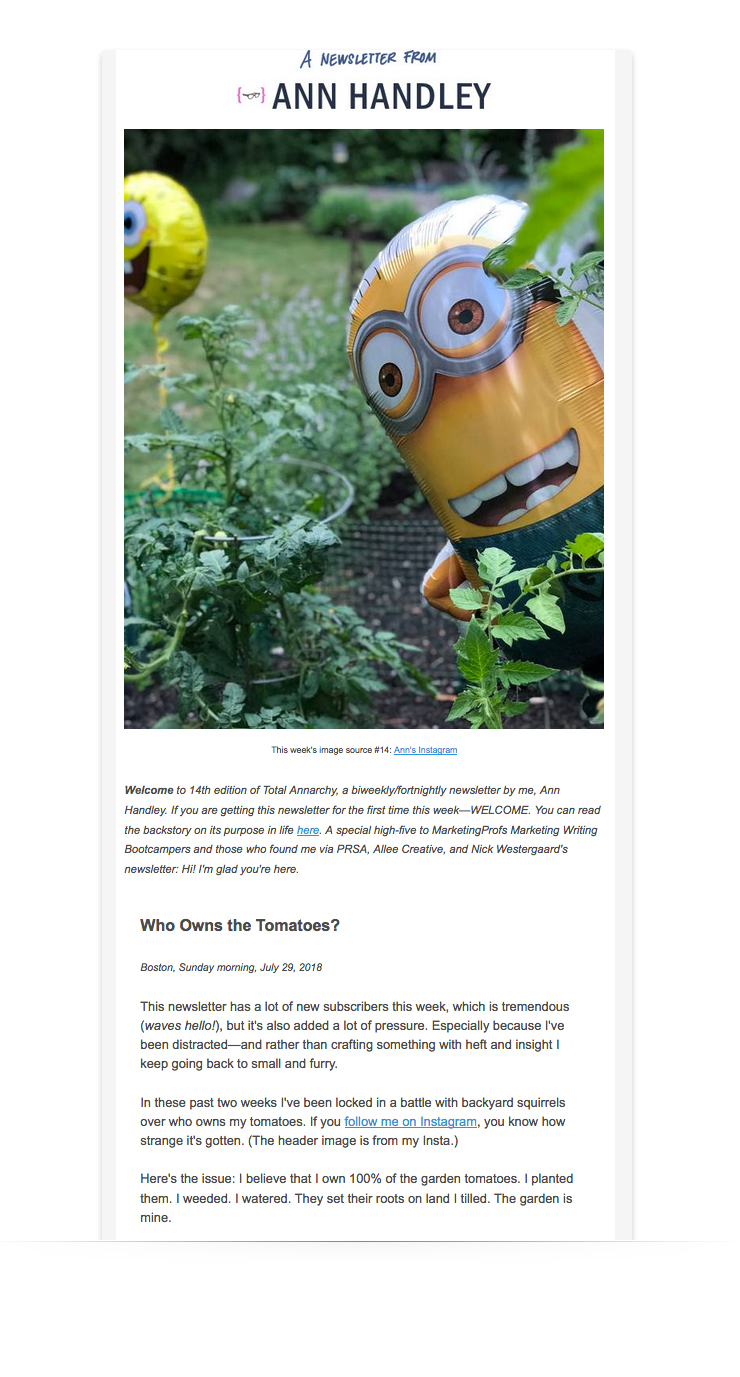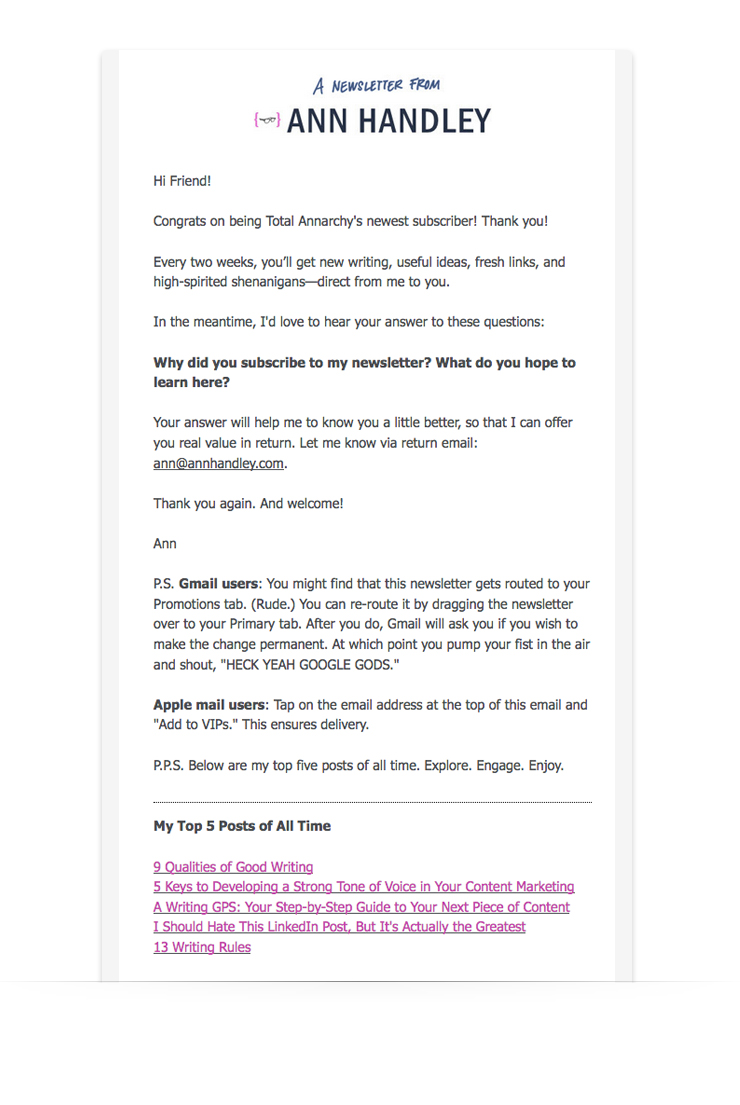Why World-Class Writer Ann Handley Completely Revamped Her Newsletter in 2018
By Liz Willits September 5, 2018
Ann Handley is a world-class writer and marketer. She’s The Wall Street Journal bestselling author of Everybody Writes and the chief content officer at Marketing Profs. She keynotes at conferences worldwide. She’s built a loyal fan following. And she’s been sending an email newsletter to her audience for years.
“My feelings about newsletters are strong. It’s the one enduring place that we have as marketers, and it’s the place where conversations are most intimate,” Handley says, noting that subscribers voluntarily opt in to your newsletter and choose to receive your emails. “[Newsletters] are 100% effective and they’re still the backbone of so many content marketing efforts.”
Yet, in 2017, she sent only four newsletters. She missed talking directly to her audience on a regular basis.
That’s why she knew it was time to approach her newsletter differently. Handley wanted something she was excited to send, and that her subscribers would be excited to open.
So in January 2018, Handley unveils her TotalAnnarchy newsletter. It was unlike any other email she had sent before.
And it’s one of our must-read newsletters.
During my interview with Handley, she explains the format of her revamped newsletter, how to gauge if your newsletter is successful, and her writing process for crafting effective emails fast.
What is TotalAnnarchy?
TotalAnnarchy is sent every other week, and it’s filled with curated content for marketers, writers, and content creators.
Handley begins each TotalAnnarchy email with a long-form essay on one topic — like Mr. Rogers, the words people hate, and even her battle with the squirrels who are eating her tomato plants. She follows this essay with content pieces she thinks are worth sharing that week, like the most common grammar mistakes people make.
Each newsletter is riveting, valuable, and beautifully written.
How to determine if your newsletter is successful
Every great newsletter helps its subscribers. It educates, amuses, or provides some kind of value. But how do you know if your subscribers are actually finding value in your emails? Email analytics and qualitative data (like responses from your subscribers) can help. For Handley, there are four email health indicators she examines to determine if her newsletter was a success on a given week:
1. Welcome email responses
When someone subscribes to TotalAnnarchy, they automatically receive a welcome email from Handley. Within this email, Handley asks subscribers why they signed up and what they hope to learn.
The responses to this question help Handley know what kind of content her subscribers prefer. “[My welcome email] has been hugely helpful in terms of figuring out what kinds of content I think will resonate the most. I keep [answers] in a spreadsheet, and I’m able to look at them and figure out what my audience is looking for. It’s a pre-metric in a way,” Handley says.
2. Email open rates
While email click-through rates are an indicator of success or failure for many email marketers, Handley doesn’t focus on them.
Instead, she examines her open rates. “Because [my newsletter] is pretty broad, I don’t obsess about the click-through rate too much. I’m more interested in the open rate and seeing how people interact with it throughout the two weeks,” Handley says. A high open rate tells her that her audience is engaged and found value in her prior newsletters.
Related: The Easiest Way to Skyrocket Your Open Rates
3. List growth
If her email list is growing, Handley knows that people are sharing her newsletter with friends and colleagues. This word-of-mouth marketing grows her list. On top of that, it demonstrates that people are getting value from her emails.
Related: How to Get Your First 50 Subscribers in 30 Days
4. Replies to her newsletter
The final indicator of email success for Handley is the number of personal email responses she receives from subscribers after sending her newsletter. If she receives an above average amount of personal notes from subscribers, her newsletter that week was especially engaging.
4 tips to streamline the writing process
Writer’s block is common. In fact, even Handley struggles with it.
“Writing is hard for me, too. A lot of writers will say that they hate to write but they love to have written. I think that is absolutely true.” To combat her own writing block and craft content more quickly, she uses four tactics:
1. Write down your ideas in a notebook or document.
When you sit down to write, a blank page can feel overwhelming. That’s why Handley recommends jotting down ideas whenever they strike.
“I carry a notebook with me pretty much anytime, anywhere I go. And I’ll just write a few lines about something I saw, something I observed, or something that just popped into my head. When it’s time for me to write, I’ll get a lot of ideas that way,” Handley says.
2. Don’t perfect your first draft.
In fact, your first draft doesn’t even need to contain full paragraphs or sentences. “A lot of people stop themselves from writing because they’re intimidated by the process. They stop themselves before they start,” Handley says.
To avoid this, Handley recommends a 4-stage drafting process:
Draft 1: Think of your first draft as a grocery list. Simply list out the points you want to make in your content.
Draft 2: Flesh out the points you wrote down.
Drafts 3 and 4: Make it your own. Add your voice. Ask yourself, “Does this content sound like it’s written by me?”
Each draft leads you another step closer to a perfected piece of content. “Writing to me is an iterative process. And I think that’s the only way to do it and to do it well,” Handley says.
3. Think about one person.
To make her writing more personal, Handley thinks about one person as she’s writing her newsletter. This could be a person she talked to during the week, a friend, or a subscriber who reached out to her with a question. Her newsletter is a personal letter to this individual.
“Think about the word ‘newsletter.’ I don’t focus on the news. I focus on the letter. That makes my voice more accessible. It makes it more human, and it also makes it a whole lot easier to just write,” Handley says.
Related: Are You a Newsletter Master or Novice? Take This Quiz to Find Out
4. Write your first draft. Walk away from it. Then edit.
Finally, Handley advises waiting before you edit your first draft. She says, “I never write something and then publish it. I always put some distance between me, my writing, and the publishing. And I do that because I believe that the editing is just as important as the writing.”
Try Handley’s email marketing platform of choice — for free!
Get AWeber Free and start sending an engaging email marketing newsletter today.
 87% off ends soon!
87% off ends soon! 
